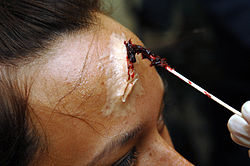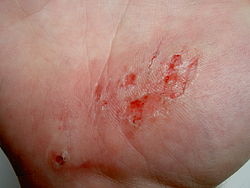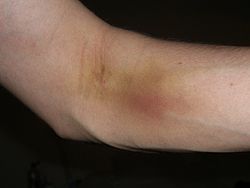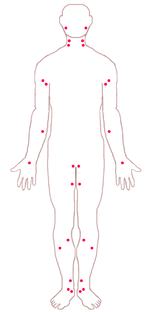- Emergency bleeding control
-
Emergency bleeding control describes the steps or actions taken to control bleeding from a patient who has suffered a traumatic injury or who has a medical condition which has led to bleeding. Many bleeding control techniques are taught as part of first aid throughout the world,[1] although some more advanced techniques such as tourniquets, are often taught as being reserved for use by health professionals, or as an absolute last resort, in order to mitigate the risks associated with them, such as potential loss of limbs.[2] In order to manage bleeding effectively, it is important to be able to readily identify both types of wounds and types of bleeding.
Contents
Types of wounds
Wounds are normally described in a variety of ways. These may deal with a description of wound size (length) and thickness, or also with the plainly visible wound characteristics. Wounds may be categorized as open or closed, or as either acute or chronic in origin.[3] The most common descriptors of wounds are these:
- Incisions: Straight edges to the wound margins, as if sliced with a knife. These can vary in size, and may be caused by a variety of objects, including a scalpel, a knife, any piece of straight, sharp metal, or a piece of glass. Tissue is rarely missing from the wound site, and the margins of the wound may be easily matched from one side of the wound to the other for the purposes of closure.[4]
- Laceration Jagged edges to the wound margins, more closely resembling a tear than a slice. The wounded tissue is random rather than straight in direction, and may have multiple branches.[5] Most often caused by an object with a broken or serrated edge, such as a piece of broken glass or metal, but may also be caused by a blow from a blunt object to tissue with bone immediately behind it.
- Puncture: Sharp object penetrates the tissue, and travels internally, but does not move laterally in any direction from the point of entry.[6] Such wounds can be misleading, as they may appear quite small on surface examination, but extend quite deeply into the body; even damaging nerves, blood vessels, or internal organs. They may cause substantial internal bleeding or secondary injuries, such as a collapsed lung, which may not be readily evident during primary assessment. Occasionally, the object causing the injury will remain in the wound as an impaled object. A stab wound from a knife or other sharp object, or a bullet wound would be examples of this type of injury. Medical professionals usually refer to this type of wound as penetrating trauma.
- Abrasion: A scraping or scratching. Generally quite superficial, and affecting only the surface layers of the epidermis.[7] No internal organs, nerves, or blood vessels other than capillaries, are affected. This may be the result of a fall, or of sliding (friction) against rough surfaces. The road rash often suffered by falling motorcyclists is an example of this type of wound.
- Contusion: Simple bruising. In this type of injury, the capillaries in the epidermis and dermis are damaged, without breaking the skin.[8] Blood oozes out of these vessels into the spaces between cells or interstitial space, causing swelling and discoloration. Blood loss is generally limited, and not of serious consequence. It may, however, act as a signpost, pointing to more serious injuries.
- Avulsion: A full thickness laceration-type wound, often semi-circular in shape. This creates a flap which, when lifted, exposes the deeper tissues to view, or extrudes them from the wound itself.[9] Avulsions often occur in mechanical accidents involving fingers (sometimes referred to as degloving), and on a more serious note, may affect the orbit of the eye or the abdominal cavity, exposing the internal viscera. Avulsions are difficult to repair, and no avulsion should ever be considered a minor injury.
- Types of wounds
-
Laceration moulage
Blood vessels affected
External bleeding is generally described in terms of the origin of the blood flow by vessel type. The basic categories of external bleeding are:
- Arterial bleeding: As the name suggests, blood flow originating in an artery. With this type of bleeding, the blood is typically bright red in colour, due to the high degree of oxygenation. Blood typically exits the wound in spurts, rather than in a steady flow. The amount of blood loss can be copious, and can occur very rapidly.[10]
- Venous bleeding: This blood is flowing from a damaged vein. As a result, it will be a darker red to burgundy in colour (due to the lack of oxygen being transported) and will flow in a steady manner. Caution is still indicated; while the blood loss may not be arterial, it can still be quite substantial, and can occur with surprising speed without intervention.[11]
- Capillary bleeding: Capillary bleeding usually occurs in superficial wounds, such as abrasions. The colour of the blood may vary somewhat (distal portion of circulation with oxygenated and unoxygenated blood mixing), and will generally ooze in small amounts, as opposed to flowing or spurting.[12]
External wound management
The type of wound (incision, laceration, puncture etc.) will have a major effect on the way a wound is managed, as will the area of the body affected and the presence of any foreign objects in the wound. The key principles of wound management are:[13]
Elevation
Keeping the wound above the level of the heart will decrease the pressure at the point of injury, and will reduce the bleeding. This mainly applies to limbs and the head, as it is impractical (and in some cases damaging) to attempt to move the torso around to achieve this. Most protocols also do not use elevation on limbs which are broken, as this may exacerbate the injury.
Direct pressure
Placing pressure on the wound will constrict the blood vessels manually, helping to stem any blood flow. When applying pressure, the type and direction of the wound may have an effect, for instance, a cut lengthways on the hand would be opened up by closing the hand in to a fist, whilst a cut across the hand would be sealed by making a fist. A patient can apply pressure directly to their own wound, if their consciousness level allows. Ideally a barrier, such as sterile, low-adherent gauze should be used between the pressure supplier and the wound, to help reduce chances of infection and help the wound to seal. Third parties assisting a patient are always advised to use protective latex or nitrile medical gloves to reduce risk of infection or contamination passing either way. Direct pressure can be used with some foreign objects protruding from a wound, and to achieve this, padding is applied from either side of the object to push in and seal the wound - objects are never removed.
Pressure points
In situations where direct pressure and elevation are either not possible or proving ineffective, and there is a risk of exsanguination, some training protocols advocate the use of pressure points to constrict the major artery which feeds the point of the bleed. This is usually performed at a place where a pulse can be found, such as in the femoral artery.[14] There are significant risks involved in performing pressure point constriction, including necrosis of the area below the constriction, and most protocols give a maximum time for constriction (often around 10 minutes). There is particularly high danger if constricting the carotid artery in the neck, as the brain is sensitive to hypoxia and brain damage can result within minutes of application of pressure. Pressure on the carotid artery can also cause vagal tone induced bradycardia, which can eventually stop the heart. Other dangers in use of a constricting method include rhabdomyolysis, which is a build up of toxins below the pressure point, which if released back in to the main bloodstream may cause renal failure
Epistaxis
- Epistaxis or a nosebleed is a special case, where almost all first aid providers train the use of pressure points. The appropriate point here is on the soft fleshy part of the nose, which should constrict the capillaries sufficiently to stop bleeding, although obviously, this will not stop bleeding which originates in the nasopharynx or the tear ducts
Tourniquet
Another method of achieving constriction of the supplying artery is via the use of a tourniquet - a tightly tied band which goes around a limb to restrict blood flow. Tourniquets are routinely used in order to bring veins to the surface for cannulation, although their use in emergency medicine is more limited. The use of the tourniquet is restricted in most countries to professionals such as physicians and paramedics, as this is often considered beyond the reach of first aid and those acting in good faith as a good samaritan. A key exception is the military, where many armies carry a tourniquet as part of their personal first aid kit.
Improvised tourniquets, in addition to creating potential problems for the ongoing medical management of the patient, usually fail to achieve force enough to adequately compress the arteries of the limb. As a result, they not only fail to stop arterial bleeding, but may actually increase bleeding due to the impaired venous bloodflow.[15] Some argue that tourniquets should never be used in the pre-hospital setting, not even for amputations.
Clotting agents
Main article: Hemostatic agentSome protocols call for the use of clotting accelerating agents, which can either by externally applied as a powder, gel or pre-dosed in a dressing, or as an intravenous injection. These may be particularly useful in situations where the wound is not clotting, which can be due to external factors, such as size of wound, or medical factors such as haemophilia.[16]
Internal wound management
Internal wounds (usually to the torso) are harder to deal with than external wounds, although they often have an external cause. The key dangers of internal bleeding include hypovolaemic shock (leading to exsanguination, causing a tamponade on the heart or a haemothorax on the lung. The aortic aneurysm is a special case where the aorta, the body's main blood vessel, become ruptured through an inherent weakness. This is one of the most serious medical emergencies a patient can face, as the only treatment is rapid surgery, although exertion, raised blood pressure or sudden movements could cause a sudden catastrophic failure.[17]
In the event of the bleeding being caused by an external source (trauma, penetrating wound), the patient is usually inclined to the injured side, in order to ensure that the 'good' side can continue to function properly, without interference from the blood inside the body cavity.
The treatment of internal bleeding is beyond the scope of simple first aid, and should be considered by any first aider to be potentially life threatening. The definitive treatment for internal bleeding is always surgical treatment, and medical advice must be sought urgently for any victim of internal bleeding.[18]
See also
References
- ^ "Bleeding". MedlinePlus. http://www.nlm.nih.gov/medlineplus/ency/article/000045.htm. Retrieved 2007-06-15.
- ^ Cyr, Dawna L; Johnson, Steven B (September 2006). "Basic First Aid". The University of Maine. Archived from the original on 2007-06-10. http://web.archive.org/web/20070610042035/http://www.cdc.gov/nasd/docs/d000701-d000800/d000799/d000799.html. Retrieved 2007-06-21.
- ^ "NHS Formulary website". http://www.formulary.cht.nhs.uk/pdf,_doc_files_etc/APC/Wound%20Formulary/3_WoundTypes.pdf. Retrieved 2009-02-03.[dead link]
- ^ "Surgeryonline website". http://surgeryonline.wordpress.com/tag/types-of-wound/. Retrieved 2009-02-03.
- ^ "Wounds (1) (Merck Manual online)". http://www.merckmanuals.com/home/injuries_and_poisoning/first_aid/wounds.html. Retrieved 2009-02-03.
- ^ "Coloplast website". http://www.woundcare.coloplast.com/EEndCom/Woundcare/Homepage.nsf/(VIEWDOCSBYID)/25DE6C10B6F7800BC1257375003AFB3D?opendocument&unid=25DE6C10B6F7800BC1257375003AFB3D. Retrieved 2009-02-03.
- ^ "Types of Wounds (Hansaplast.com website)". http://int.hansaplast.com/med-info/wound-care-beautiful-healing/types-of-wounds.html. Retrieved 2009-02-03.
- ^ "Contusions (CCODC website)". http://www.ccodc.org/downloads/CONTUSIO.pdf. Retrieved 2009-02-03.[dead link]
- ^ Benjamin Gulli; Thygerson, Alton L. (2005). First aid, CPR, and AED. Boston: Jones and Bartlett. pp. 117. ISBN 0-7637-3016-5.
- ^ "U.S. Navy Standard First Aid Manual, Chapter 3 (online)". http://www.brooksidepress.org/Products/OperationalMedicine/DATA/operationalmed/Manuals/Standard1stAid/chapter3.html. Retrieved 2003-02-03.
- ^ "Severe Bleeding (Univ. Michigan Medical School website)". http://www.med.umich.edu/1libr/pa/pa_bleedsev_hhg.htm. Retrieved 2009-02-03.[dead link]
- ^ "Control Bleeding (SUNY website)". http://www.ic.sunysb.edu/Stu/wilee/e-zine-controlbleeding.html. Retrieved 2009-02-03.
- ^ "Emergency Bleeding Control (St John Ambulance Western Australia website)". http://www.stjohn.org.au/images/stjohn/information/severe%20bleeding%20june07%20v1.pdf. Retrieved 2009-01-05.[dead link]
- ^ "Bleeding (U.S. Navy Standard First Aid Manual online". http://www.brooksidepress.org/Products/OperationalMedicine/DATA/operationalmed/Manuals/Standard1stAid/chapter3.html. Retrieved 2009-02-03.
- ^ "New Guidelines (AHA Journal Circulation online)". http://www.circ.ahajournals.org/cgi/content/full/102/suppl_1/I-77. Retrieved 2009-01-03.
- ^ "MedMarketDiligence website". http://www.prlog.org/10076809-wound-types-and-advanced-wound-products-market-worldwide-medmarket-diligence-report-s245.html. Retrieved 2008-02-03.
- ^ "Aneurysms (Merck Manual online)". http://www.merckmanuals.com/home/heart_and_blood_vessel_disorders/aneurysms_and_aortic_dissection/aneurysms.html. Retrieved 2009-02-03.
- ^ "Internal Bleeding: First Aid (Merck Manual online)". http://www.merckmanuals.com/home/injuries_and_poisoning/first_aid/internal_bleeding.html. Retrieved 2009-02-03.
First aid Techniques Equipment Mnemonics Certifications Topics Emergency medical services around the world Emergency medical services by country Austria · Australia · Canada · France · Germany · Hong Kong · Iceland · Ireland · Israel · Italy · Netherlands · New Zealand · Norway · Poland · Portugal · Spain · South Africa · Sri Lanka · United Kingdom · United StatesParamedics by country Categories:
Wikimedia Foundation. 2010.





